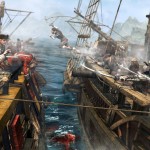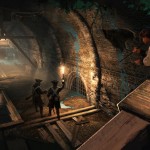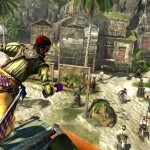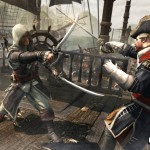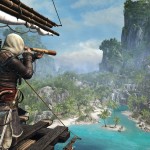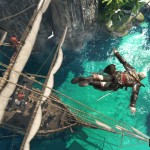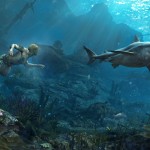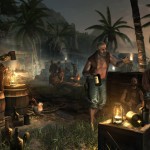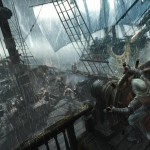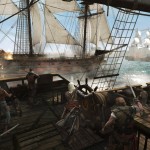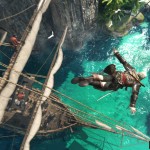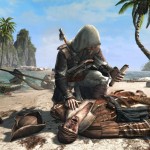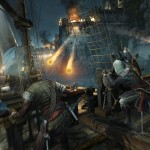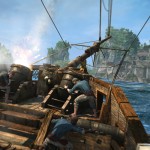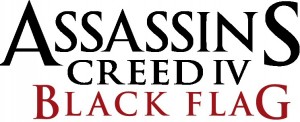 I’ll admit it. Even though I thoroughly enjoyed Assassin’s Creed III, I was ready to throw in the towel on the series, figuring they had done everything worth doing, and the unsatisfying cliffhanger it ended on just felt like more evidence of that. It’s not easy to hold people’s interest when you go back to the same well year after year with the release cycle Ubisoft continues to push, but once again with Assassin’s Creed IV: Black Flag, they have done just enough to pique my fancy, and hopefully yours as well, by building upon the most promising elements of the previous edition.
I’ll admit it. Even though I thoroughly enjoyed Assassin’s Creed III, I was ready to throw in the towel on the series, figuring they had done everything worth doing, and the unsatisfying cliffhanger it ended on just felt like more evidence of that. It’s not easy to hold people’s interest when you go back to the same well year after year with the release cycle Ubisoft continues to push, but once again with Assassin’s Creed IV: Black Flag, they have done just enough to pique my fancy, and hopefully yours as well, by building upon the most promising elements of the previous edition.
The story facilitates matters by taking things a little further back from the Revolutionary War era, to a Welsh privateer turned pirate named Edward Kenway (the grandfather of Assassin’s Creed III’s protagonist, Connor Kenway). Through his latest plot in pursuit of wealth, he unwittingly stumbles into in the middle of the centuries old conflict between Assassins and Templars, leading a crew and later a fleet into battle across the Caribbean that also involves the navies of Spain and Britain, of course. This is probably the aspect of the game that doesn’t quite live up to its predecessors in the sense that there is not as much recorded history to lean on here, so the writers were able to take liberties with the plot that tie things together a bit more loosely. It also avoids for the most part the existential questions that the last game brought up about who are really the good guys in all this, probably because of the way Edward gets quickly whisked up into things. The same goes somewhat for the present day portion of the game, which centers around the player working for Abstergo Entertainment (which looks and sounds a lot like an idealized Ubisoft, even down to the detail of being based in Montreal.. hmm..), a front for the Templars in the war for humanity’s future. Unlike Assassin’s Creed III, this portion of the game is mostly optional and doesn’t take you out of the Animus for long. Without spoiling too much, you’ll see some familiar faces and references, but for the most part it’s friendly to those new to the series, without wasting anyone’s time recapping previous events.
And what should attract those new gamers is the vastly expanded gameplay, thanks to the theme of piracy. If you have dismissed Assassin’s Creed for being too much of a closed, mostly urban sandbox with not much to do besides perform hits on people, well Assassin’s Creed IV: Black Flag should be the cure for what ails you. It takes the brief naval excursions from the previous game and transforms them into the ultimate open world pirate’s playground. As the captain of the Jackdaw, you can set sail for anywhere between the southern coast of Florida to the island of Hispaniola and even the Yucatan peninsula. Along the way you’ll catch in your spyglass several schooners, brigs, gunboats, and frigates from England and Spain, each of varying strengths. If you fancy your odds, you can fire your cannons, mortars, fire barrels, and chain shots at any of them to plunder them for their booty (various resources like wood, metal, rum, and sugar, the latter two of which can be sold for more Reales, or gold, and the rest can be used to upgrade your ship’s hull and weaponry). Once you get an enemy ship’s health down enough, you can either board them in which case you’ll have to take out a given number of soldiers or sink them altogether and scoop up what remains. The former is preferred of course as it allows you to salvage more resources and crew, as well as use the ship to repair your own or lower your wanted value, which if it reaches high enough, will send hunter ships specifically after you, basically replacing the similar mechanic previously encountered within cities. Another option for a captured ship is to add it to your fleet, which basically participates in a resource collecting and trading mini game similar to the one in the Vita game, Assassin’s Creed III: Liberation. Templar towers have been replaced with seaside fortresses, whose defenses must be destroyed before you can dock and infiltrate them in order to free up the restricted areas and turn them around into traps for your rivals, because yes those cannons will be used to sink them from shore, which is absolutely fun to watch.
When you’re tired of all the naval warfare (and seriously why would you be? I found it to be the most addictive part of the game), there’s still plenty of stuff to do, particularly on foot. Speaking of which, the transition between sailing and reaching land is entirely seamless outside of the major cities, pretty remarkable considering how much space that covers. That’s good because there’s plenty of treasure and hunting (another returning mechanic from Assassin’s Creed III, including crafting your own upgrades) to seek out on various smaller islands and caves littered across the map. And yes by treasure I mean, there’s classic treasure maps where X marks the spot and all. Of course the gameplay of most of the story missions is pretty much old hat by now, and there’s no real new weapons of note here, except for the fact that Edward Kenway is able to dual wield his swords much like Connor works his tomahawks. However the difficulty of the fighting continues to be tweaked so that it no longer is the “press counter to win” fest that previous games were, and once again your health only refreshes out of combat which means you have to be efficient. I also thought the missions were better designed in this game in the sense that there were more wide open areas that forced you to use stealth but in fair way that gave you more options than one. There’s still all the collectibles and challenges to get 100% sync, BTW, and not only can you upgrade your ship and weapons but you can also build out your pirate’s cove with all the stores and such you need. Plus there’s all the side quest assassination and naval contracts to carry out so all in all there’s just hours and hours of gameplay stuffed into this. And I haven’t even touched on the multiplayer, but that’s because it’s mostly the same as the last game, except with the addition of Game Lab mode which allows you to customize just about every rule and setting you can think of. Ubisoft claims it will make the most popular Game Lab creations a new default mode in the game, so there’s that I guess. Personally my favorite is the Wolfpack co-operative mode introduced last year, which also has a campaign tied into it. If you haven’t tried multiplayer in the series yet I highly suggest it in any case as it’s a very unique experience that focuses on deception skills over sheer reflexes.
Having previously reviewed the 360 version, I must say the graphics on the next-gen Playstation 4 version are a quite noticeable step up, and not just because the resolution has been upgraded to 1080p. The game also runs a lot smoother, most notably in the large towns and fortresses, and when the camera pans out wide during synchronizations and such, showing off the increased draw distance as well. Cutscenes no longer feature that dithered shading effect (to be fair, the Wii U version of AC3 also did away with that) Water reflects the surroundings and is more clear as well as looking less polyognal. Rain is much more visible and you can see it collect on your ship as lightning crashes down around it. Even the first person, real world segments are much better looking in this version. Is it enough to justify the price of a new system alone? Maybe not unless you’re a real diehard, but you will not be disappointed I assure you. Still the versions of the game for the older systems are still quite beautiful and playable in their own right, and credit must be given to Ubisoft for making the engine that runs it all so scaleable. Another reason you might want to get the PS4 version is for the Remote Play feature which allows you to play the game on your Vita. I’m happy to report that it works fantastically, and the developers even took care to modify the default control mapping into something much easier to use (most Remote Play games will map the L2 and R2 triggers to the rear touchpad, but since you use them so often in AC4 they’re mapped to the shoulder buttons, a nice touch). PS3 and PS4 owners also get access to an extra hour or so of gameplay which continues the story of Aveline de Grandpre, which is great for us fans of the Vita exclusive AC3: Liberation.
Moving on, the voice acting and music is phenomenal once again, and Edward is certainly gobs more charismatic than his grandson was, capturing the ethos of a pirate quite well without shamelessly borrowing from other pirates like Jack Sparrow. As an aside there’s a “cheat” mode of the game that allows you to switch Edwards speech for the stereotypical tropes like “yarr” and “matey” popularized in movies and the like. It’s quite hilarious!
Quite frankly, you don’t even have to be a huge fan of the franchise to enjoy Black Flag. The open world naval elements make up what amounts to a fantastic game on its own, giving us a way to simulate all our pirate fantasies in way that’s been long overdue. The fact that it’s attached to a compelling story and third person action game in its own right is almost an absurd bonus at this point. The only question is whether you should get this game now or wait to see if the next gen versions are much better. That and what Ubisoft could possibly do to stay fresh after this one.
Gameplay
Graphics
Sound
Overall
Assassins Creed IV Black Flag Screenshots:
- Assassin’s Creed IV Black Flag Review – Xbox 360 (Also on PlayStation 3 and Wii U)


